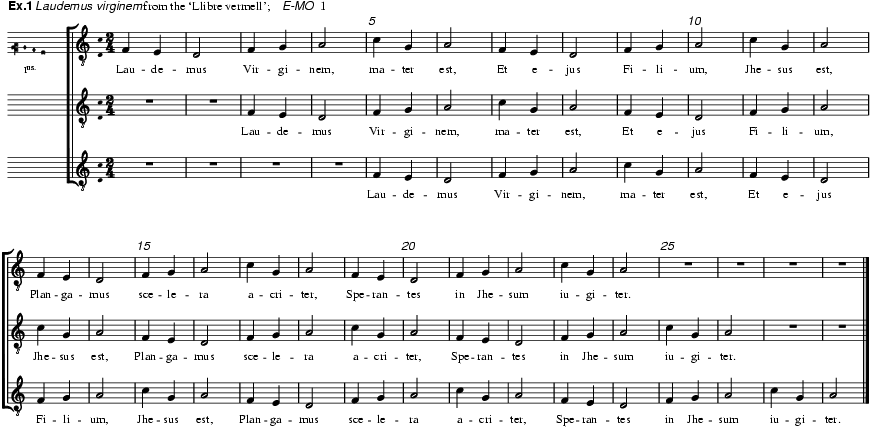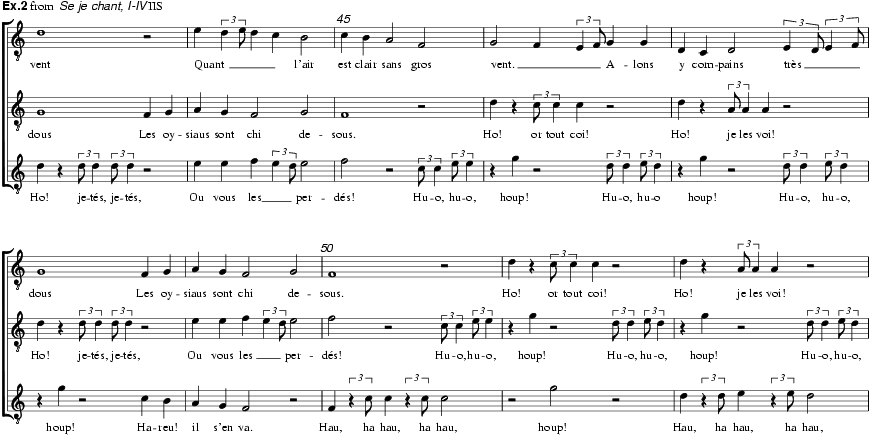
(Fr.; Sp. caça).
A 14th-century term for canon (see Canon (i)). It is generally applied by modern writers to a small number of 14th-century French-texted, three-voice canons at the unison employing onomatopoeia and word-painting. Various forms of the verb ‘chacer’ (e.g. ‘chasser’) also appear in the sources, indicating that a given melody is to be realized canonically.
Apparently unknown before 1300, the term ‘chace’ is not included in Johannes de Grocheio's compendium of secular genres (Ars musice, c1300). ‘Chaches’ are listed, however, along with ‘motes’, ‘rondiaux’, ‘hoques’, ‘estampies’ and ‘balades’, in an anonymous mid-14th-century translation and adaptation of the 13th-century Ludus super Anticlaudianum by Adam de la Bassée. The chace was mentioned again in Don Pedro Niño's list of French polyphonic genres sung at the residence of Regnauld de Trie, Amiral de France, in 1406. The chronicler Mathieu d'Escouchy reported that a ‘chasse’ was performed during the Feast of the Pheasant at Lille in 1454, and that it ‘imitated the barking of little dogs and the sounding of trumpets, just as if we were in a forest’; although canonic realization is not mentioned, this could be a late reference to the mimetic chace.
While literary allusions suggest that the chace constituted a distinct genre, in the musical sources the designation ‘chace’, like its Italian counterpart Caccia, seems to have been understood primarily as a clue to canonic realization, without reference to textual or musical style. The textless ‘chace’ for two voices that Jehan Lebeuf d'Abbeville en Pontieu added in 1362 to a late 11th-century plainchant manuscript (F-CHRm 130, f.50v) appears to be an extremely simple circular canon, and the pilgrims' songs labelled ‘caça’ in the late 14th-century ‘Llibre vermell’ (E-MO 1, ff.21v–23; ed. in PMFC, xxiiiB, 1991) are round canons for two or three voices that untrained singers might easily have learnt without the benefit of notation (ex.1).

Four chaces survive in the late 14th-century Ivrea manuscript (I-IV 115; ed. in CMM, liii/3, 1972, and PMFC, xx, 1982). Talent m'est pris, identified as a ‘chasse de septem temporibus fugando et revertendo’, is a round canon with imitations of cuckoo calls. It appeared in early 15th-century sources with two new German texts, Der sumer kumt (CZ-Pu XI.E.9; F-Sm C.22, now lost) and Die minne füget niemand (A-Wn 2777 and Iu Wo, by Oswald von Wolkenstein). The other three chaces in the Ivrea manuscript are extended, continuous canons. Although they are not identified as chaces, realization in canon at the unison for three voices at a time interval of five longs is inherent in their melodic and rhythmic structure. Another chace, known only by its explicit … et belle amie a mon talent, survives incomplete in two sources (F-Pn 67 and US-R 44). Hareu, hareu, je la voy, listed in the index (F-Pn 23190) of the lost Tremoïlle manuscript, is identified as a ‘cantus trium vocum cum fuga 9 temporum’ in Coussemaker's inventory of the lost Strasbourg manuscript F-Sm C.22; it too seems to be a mimetic chace on a hunting theme.
In all three of the extended Ivrea chaces, opening and closing sections in slow modus rhythm frame a more animated middle section, in which short onomatopoeic exclamations are employed in hocket. Se je chant, probably composed by Denis le Grant, Bishop of Senlis (d 1352), depicts a hunt as a metaphor for the technique of canonic imitation (ex.2); Tres dous compains levez sus parodies a dawn song with its lively imitations of musical instruments (as does the closely related virelai Or sus vous dormes trop), while Humblemens vos pri merchi is a comic dispute between two rustic suitors.

The texts of these chaces, loosely organized in rhymed heptasyllabic lines, draw heavily on the imagery and language of the pastourelle. In contrast to the Italian caccia, the basis of musical organization in the chaces is primarily rhythmic and harmonic rather than melodic, a feature they share with the Ars Nova motet. That chace and motet were thought of as related genres is suggested by the index (F-Pn 23190) of the lost Tremoïlle manuscript, where three chaces (two of them concordant with Ivrea) were listed in the motet section. The restricted circulation of the mimetic chaces and the close interrelationship of their sources suggest that they originated in a courtly ecclesiastical milieu, where they were cultivated from the 1320s until late in the century.
None of Machaut's canonic works employs onomatopoeia or word-painting, and while he assigned the lais, rondeaux, virelais and ballades to separate sections in his manuscripts, he apparently did not consider the canon as an independent genre. In one of the lais, Je ne cesse de prier, canonic realization of alternate strophes is indicated by the term ‘chace’, while the rubric ‘iterum et sine pausa’ calls for circular repetition of the melody for the second half of the stanza. By analogy, ‘statim et sine pausa dicitur secundus versus … et sic de omnibus aliis’ at the end of the first strophe of S'onques douleureusement indicates canonic realization of all 12 stanzas. The clue to canonic interpretation of the triple-texted ballade Sanz cuer m'envois/Amis dolens/Dame, par vous is provided by initial rests in the second voice, rather than by a label or rubric.
Late 14th- and early 15th-century canonic chansons, though not explicitly designated chaces, often retain the verb forms ‘chacer’ and ‘chassant’ in a canonic rubric or embedded in the poetic text. Thus the rubric in rondeau form that accompanies Jacob de Senleches' virelai La harpe de melodie instructs the second voice to read from the first, ‘chassant deux temps sans fourvoiier’; Baude Cordier’s rondeau Tout par compas suy composés contains the clue ‘trois temps entiers chacer me pues joyeusement’; and an anonymous canon from the manuscript I-TRmp 87 opens with the line ‘Casse moy, je vais devant’ (ed. in CMM, xxxviii, 1967). By the early 15th century, the term ‘fuga’, implying flight rather than pursuit, had begun to replace ‘chace’ in musical sources. Jacobus of Liège had already (c1330) listed fuga without comment as a category of discant, along with conductus, motet, cantilena and rondellus, in his Speculum musice, book 7.
G.M. Suñol: ‘El cants dels Romeus (segle XIV)’, Analecta Montserratensia, i (1917), 100–92 [facs. of the 3 caças]
H. Besseler: ‘Studien zur Musik des Mittelalters, I: neue Quellen des 14. und beginnenden 15. Jahrhunderts’, AMw, vii (1925), 167–252, esp. 251 [edn of Se je chant, 2vv]
F. Kammerer: Die Musikstücke des Prager Kodex XI.E.9 (Brno, 1931), 25ff, 137–8 [edn of Talent in 3 versions]
L. Feininger: Die Frühgeschichte des Kanons bis Josquin des Prez (um 1500) (Emsdetten,1937), 8–14
N. Pirrotta: ‘Per l'origine e la storia della “caccia” e del “madrigale” trecentesco’, RMI, xlviii (1946), 305–23; xlix (1947), 121–42
J. Handschin: ‘The Summer Canon and its Background’, MD, iii (1949), 55–94, esp. 80 [contains edn of Talent]
H. Anglés: ‘El “Llibre Vermell” de Montserrat y los cantos y la danza sacra de los peregrinos durante el siglo XIV’, AnM, x (1955), 45–68, esp. 57 [contains edns of the 3 caças]
G. Reaney: ‘The Ballades, Rondeaux and Virelais of Guillaume de Machaut: Melody, Rhythm and Form’, AcM, xxvii (1955), 40–58, esp. 57 [edn of Machaut, Sanz cuer]
A.L. Ringer: The Chasse: Historical and Analytical Bibliography of a Musical Genre (diss., Columbia U., 1955)
J. Croy: The Chaces in the Manuscript Ivrea (thesis, Columbia U., 1967)
M.P. Hasselman: The French Chanson in the Fourteenth Century (diss., U. of California, Berkeley, 1970), i, 137–42; ii, 19 [edn of the chace in F-CHRm 130]
V.E. Newes: ‘Chace, Caccia, Fuga: the Convergence of French and Italian Traditions’, MD, xli (1987), 27–57, esp. 27–9
V.E. Newes: Fuga and Related Contrapuntal Procedures in European Polyphony ca.1350–ca.1420 (diss., Brandeis U., 1987), 57–61, 72–150
V.E. Newes: ‘Turning Fortune's Wheel: Musical and Textual Design in Machaut's Canonic Lais’, MD, xlv (1991), 95–121
K. Kügle: The Manuscript Ivrea, Biblioteca Capitolare 115: Studies in the Transmission and Composition of Ars Nova Polyphony (diss., New York U., 1993), 258–82
VIRGINIA E. NEWES